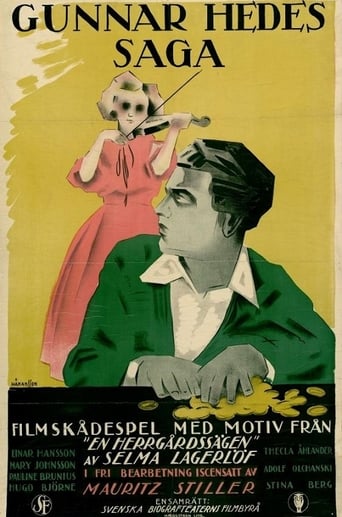lambchopnixon
Why on earth do people with not a clue about the area the spouting off about nevertheless come off as some kind of authority on the subject. Witness the reviews so far here - those with marks given. One reviewer describes the plot as ludicrous. This person must have no understanding either of non-English speaking cinema, which ordinarily recognises that what people would normally do in a set of circumstances isn't what everyone would do. The former is the cinema of the average, and in fact, even 'the average' is a fallacy, seeing as in all the little details of how we all are, we are far more odd and unexpected than non-'ludicrous' cinema gives us credit for. Gunar Hedes Saga is another wonderful film by one of three masters of Swedish cinema - Mauritz Stiller. Those who do know about silent film commonly dismiss Stiller as 'cleverer' than Victor Sjostrom - the other brilliant Swedish director the teens and twenties (before Hollywood) - as if this is a bad thing. He cleverness, or rather mastery of the possible capacity of the camera, is certainly on display here. Though it would not be said, Stiller lost out to Sjostrom by not being 'truly' making Swedish film, despite the fact that he embraced the (Swedish) outdoors and its mystical power, and used Swedish actors and personnel, though he himself was Finnish of an ancestry of Russian Jews. His hold on greatness is shaken by this - though no-one will say it - that he isn't as convenient as Sjostrom to the history of Swedish silent film, or that of the teens/20's. The acting here is excellent despite what has been said, not exaggerated but expressing states of mind that are out there in the world every day, though the cinema of the average wouldn't admit it. This and Herr Arnes Pengar are marvelous, groundbreaking films . Stiller and Sjostrom were creating cinema wonderfully fresh compared to what went before. Murnau is always given credit for this for his work of the '20's, but before he came along, these two Swedish filmmakers - both of them - were shoving those boundaries back also. Stiller didn't act and so didn't bind himself to a smaller talent for it than directing, as Sjostrom did. Ingeborg Holm - way back in 1913 - shows what Sjostrom could do with actors when he took himself out of the frame. Terje Vigen has Sjostrom in practically every scene, and would benefit from a little less in what is otherwise another brilliant film.
oOgiandujaOo_and_Eddy_Merckx
This film was recently restored (not digitally) by the Swedish film institute, had its original intertitles reinserted and received colour tinting via filters (hand tinting would have bee desirable but was not cost effective here).The storyline has an overegging of hysteria even by silent movie standards with both leads waifish, prone to fainting, and racoon-eyed, as was the fashion of the time! The plot is also quite ludicrous. I think the film is important for two reasons though, firstly I think it's interesting to look at the material that influenced of Ingmar Bergman. You can definitely see that here with the travelling artistes that first unite our two sensitive young ones. Secondly, the montage is very good in places, including a painting that comes to life, a nasty dream sequence, and a quite weird animal-phobic hallucination.Gunnar Hede is frustrated at his existence in the tomb of Munkhyttan, the family pile. Grandad, who he hears stories about was an itinerant fiddler before striking it rich with a dangerous reindeer-importing scheme. Gunnar yearns to emulate his grandfather, but mother will have none of it. The scenes that the movie is famous for show reindeer driving, and includes an astonishing river crossing where the reindeer swim across a wide river, snaking away with the current. Gunnar must earn Munkhyttan and win the girl. That is the movie! It may sound strange but the most touching scene for me was of Ingrid helping Gunnar during a weak moment, it is so rare to see a woman helping a man in a movie. I heard somewhere recently that, "the one thing women will never forgive in a man, is weakness".One very pretty scene was Gunnar staring at himself in the water, not quite sure how they filmed it, it looked as if I the audience member were staring at my own reflection!
damirradic14
'Gunar Hedes saga' is fine example of Mauritz Stiller art and exceptional treatment of nature in Swedish early films, especially by Sjöstrom and Stiller. Snow scenes with reindeers are simply beautiful. I strongly recommend for fans of silent films.
psteier
Gunnar Hede is raised by a strict mother, who wants him to become respectable to match his family's wealth. He is more interested in his grandfather, who started as an itinerant violin player, but got rich by leading a herd of wild reindeer south to market. He falls for a violinist working with a married couple of traveling performers and renounces his fortune to go with them. He then tries to earn a fortune by driving reindeer to market, but it doesn't work out and he goes insane. He is finally restored to sanity by the violinist when she returns with the performers.The most fun part are the couple (Blomgren and Stava), though they only get a few minutes screen time. The shots of the reindeer are interesting, and the shots of Gunnar Hede being dragged through the snow by a reindeer are well done.
